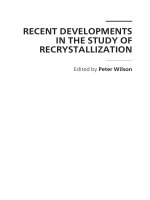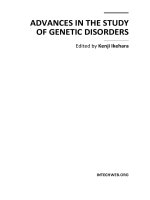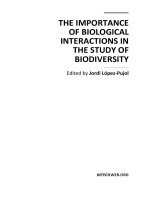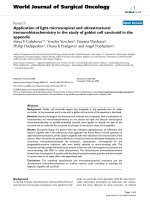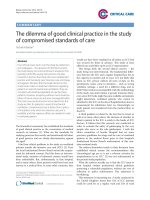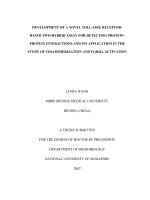In silico approaches in the study of traditional chinese herbal medicine
Bạn đang xem bản rút gọn của tài liệu. Xem và tải ngay bản đầy đủ của tài liệu tại đây (2.3 MB, 198 trang )
IN SILICO APPROACHES IN THE STUDY OF
TRADITIONAL CHINESE HERBAL MEDICINE
UNG CHOONG YONG
(B.Sc, University of Malaya, Malaysia; MSc, National University of
Singapore, Singapore)
A THESIS SUBMITTED
FOR THE DEGREE OF DOCTOR OF PHILOSOPHY
DEPARTMENT OF PHARMACY
NATIONAL UNIVERSITY OF SINGAPORE
2008
ii
Acknowledgements
First and foremost, my thanks and appreciation go to my supervisor, Associate
Professor Chen Yu Zong of the Pharmacy Department for your innovative insights,
excellent guidance, words of wisdom, constant supports and patience throughout my
study.
Besides, I would like to express my deepest appreciation to my close
collaborator, Dr Li Hu for his great help and support during this period. I really enjoy
the brain storming discussion with you during our regular coffee break and really
learn a lot. Without your effort the completion of my current thesis is not possible.
I would like to expression my deep appreciation to A/P Tan Tin Wee, A/P
Chung Ching Ming Maxey for your valuable assistance in teaching, research, and
other administrative stuffs. My thanks to all the members in BIDD group for their
kind supports.
I wish to say thank you to my dear friend Zhao Yingfang for her consistent
support and love throughout this period of time.
I would like to express my deepest thanks to my parents for their love and
support throughout my life although my father was passed away during my study
about two years back.
iii
Finally, I am very grateful to the National University of Singapore for
awarding me the Research Scholarship during my PhD candidature.
Table of Contents
Acknowledgements ii
Table of Contents iii
Summary viii
List of Tables x
List of Figures xiiii
List of Publications xvii
List of Abbreviations xix
Chapter 1 Introduction: Overview of Current Status in TCM Research and the
Motivation in this Study 1
1.1 The Need of Revisiting the Research on TCM 1
1.2 Brief Introduction of TCM Principles from Traditional Point of Views 5
1.2.1 The Yin-Yang theory 5
1.2.2 The Wu Xing theory (the theory of five elements) 7
1.2.3 The Zhang Fu theory (the theory of meridians) 7
1.2.4 Diagnosis and treatment in TCM 8
1.2.5 Pharmacological classification of TCM herbs 9
1.3 TCM Research in the “Omics” Era 10
1.4 In Silico Approaches in TCM Research 11
1.5 Motivation and In Silico Approaches Used in this Study 12
iv
Chapter 2 Use of Machine Learning Methods (MLMs) in the Study of TCM from the
Traditional Point of Views 15
2.1 Introduction 15
2.2 Methods 19
2.2.1 Selection of TCM prescriptions and non-TCM recipes 19
2.2.2 Digital representation of herbs and multi-herb recipes 22
2.2.3 Machine Learning Methods (MLMs) 23
2.2.3.1 k-Nearest Neighbor (kNN) 23
2.2.3.2 Support Vector Machine (SVM) 25
2.2.4 Determination of generalization ability of MLM classification systems 27
2.3 Results 28
2.3.1 Distribution pattern of TCM-HPs and characteristics of TCM prescriptions 28
2.3.2 Usefulness of TCM-HPs for distinguishing TCM prescriptions from non-
prescription recipes 30
2.3.3 Misclassified TCM prescriptions 32
2.4 Discussion and Conclusion 32
Chapter 3 Pattern Analysis of TCM Herb Pairs Using Machine Learning Methods
from the Traditional Point of Views 36
3.1 Introduction 36
3.2 Methods 38
3.2.1 Digital representation of herbs and herb pairs 38
3.2.2 Selection of TCM herb-pairs and construction of non-TCM herb-pairs 42
3.2.3 Machine Learning Methods (MLMs) 43
3.2.3.1 Probabilistic Neural Network method (PNN) 43
3.2.3.2 k Nearest Neighbor (kNN) 43
v
3.2.3.3 Support Vector Machine (SVM) 44
3.2.3.4 Methods for validating MLM classification systems 44
3.2.3.5 Evaluating the Prediction Performance of Stistical Learning Methods
(MLMs) 45
3.3 Results and Discussion 46
3.3.1 Distribution patterns of TCM-HPs of TCM herb-pairs and their characteristics .46
3.2.3.2 Usefulness of TCM-HPs for distinguishing TCM herb-pairs from non-
TCM herb-pairs 51
3.4 Discussion and Conclusion 52
Chapter 4 Identification of Metastatic-Related Targets of Rhubarb Anthraquinones by
an Inverse Docking Approach 55
4.1 Introduction 55
4.2 Methods 59
4.2.1 The Algorithm of INVDOCK 59
4.2.2 Validation of INVDOCK Results on Targets of Rhubarb Anthraquinones 62
4.3 Results 63
4.3.1 Targets Identified from INVDOCK and Comparison to Known Targets of
Rhubarb Anthraquinones 63
4.3.2 Metastatic-Related Targets of Emodin, Aloe-Emodin, and Rhein Identified by
INVDOCK 75
4.4 Discussion 80
4.4.1 Metastatic-Related Targets of Rhubarb Anthraquinone Emodin, Aloe-Emodin,
and Rhein Identified from INVDOCK Search 80
4.4.2 Limitations and Future Improvement of INVDOCK and Plans to Incorporate
INVDOCK Results with Experimental Works 82
vi
Chapter 5 The Study of Molecular Mechanism of Synergistic Effects in Herbal
Ingredients 84
5.1 Introduction 84
5.1.1 Needs of evaluating synergistic mechanisms of herbal recipes ……………… 84
5.2 Methods………………………………………………………………………… 89
5.2.1 Literature search method for cases of drug-drug interactions………………….89
5.2.2 Literature search method for cases of herbal synergism……………………….90
5.3 Results……………………………………………………………………………91
5.3.1 Pharmacodynamically additive, synergistic, and antagonistic combinations of
clinical drugs…………………………………………………………………………91
5.3.2 Pharmacokinetically potentiative and reductive combinations……………… 94
5.3.3 Literature described cases of herbal synergism……………………………….104
5.3.4 Assessment of herbal synergism determination methods…………………… 105
5.3.5 Modes of putative molecular interactions contribute to synergism of herbal
ingredients………………………………………………………………………… 107
5.3.6 Literature reported molecular interaction profiles of herbal active
ingredients………………………………………………………………………… 108
5.4 Discussion………………………………………………………………………134
5.4.1 Current opinions and investigations of herbal synergism…………………….134
5.4.2 Do literature-described molecular interactions of active herbal ingredients
support the reported synergism in some herbs or herbal products? 135
5.4.3 Cases of pharmacodynamic synergism interacting with different targets of the
same pathway……………………………………………………………………….136
5.4.4 Cases of pharmacodynamic synergism interacting with different targets of
related pathways…………………………………………………………………….138
vii
5.4.5 Cases of pharmacodynamic synergism interacting with different targets of both
the same and related pathways…………………………………………………… 140
5.4.6 Cases of pharmacodynamic synergism interacting with the same target…… 141
5.4.7 Cases of pharmacokinetically potentiative effect…………………………… 142
5.5 Conclusion………………………………………………………………………142
Chapter 6 Conclusion 147
6.1 Major Contributions and Findings 147
6.1.1 Merits of MLMs in the studies of TCM from Traditional Point of Views 147
6.1.2 Merits of Using Inverse Docking Approach in the Study of Anti-Metastatic
Activities of Rhubarb Anthraquinones 149
6.1.3 Merits of Using Literature-Based Approach in the Study of Mechanism of
Herbal Synergism 150
6.2 Limitations and Suggestions for Future Studies 150
Bibliography 153
viii
Summary
Recent development of Systems Biology in this “omics” era reinforced the
therapeutic strategy of considering human systems as a whole. This “holistic”
approach had been long practiced in traditional medicines such as traditional Chinese
medicine (TCM). Multi-herb prescriptions have been routinely used in TCM
formulated by using TCM-defined herbal properties (TCM-HPs) where the scientific
basis is unclear. These multi-herb prescriptions often include special herb-pairs
responsible in mutual enhancement, assistance, and restraint. Machine learning
methods (MLMs) such as support vector machine (SVM) are used to explore the
scientific basis of TCM prescription formulation. The studies reveal that MLMs are
capable of classifying TCM prescriptions and herb pairs from those of random herb
combinations showing that there is hidden scientific rule in the formulation of TCM
prescriptions for which the molecular mechanisms are still unknown. Besides, a
structural approach using inverse docking method (INVDOCK) is used to identify
putative metastatic-related targets of Rhubarb anthraquinones such as emodin, aloe-
emodin, and rhein from a protein structure database. Some targets identified by
INVDOCK had been confirmed experimentally. The results implicate additive or
synergistic effects of Rhubarb anthraquinones in anti-metastasis when used in
combinations. In addition, current study of herbal synergism using literature-based
approach reveals multiple mechanisms that involve either similar or distinct molecular
targets as well as signaling pathways. In general, current in silico approaches used in
this study covered both traditional and molecular aspects of TCM from top-down and
bottom-up directions. More rigorous studies in the understanding of holistic
ix
pharmacological mechanisms of TCM are needed and are believed to provide insight
for incorporating Systems Biology in drug development.
x
List of Tables
Table 1.1 Pharmacological classifications of TCM Herbs. This table is derived from
[Cheng 2000]. 4
Table 2.1 List of Traditional Chinese Medicine herbal properties (TCM-HPs). These
properties are classified into four classes, characters (Class C), tastes
(Class T), meridians (Class M), and toxicity states (Class
Tox) 17
Table 2.2 Traditional Chinese Medicine (TCM) prescription and non-TCM recipe
classification accuracies of the machine learning classification systems, k
Nearest Neighbor (kNN) and Support Vector Machine (SVM), evaluated
by 3-fold cross validation study 31
Table 3.1 List of Traditional Chinese Medicine herbal properties (TCM-HPs). These
properties are classified into four classes, characters (Class C), tastes
(Class T), meridians (Class M), and toxicity states (Class Tox). These are
further divided into 5, 5, 2, and 2 sub-classes for C, T, M and Tox
respectively, each of which include 11, 12, 12, and 4 TCM-HPs. The total
number of unique TCM-HP vector for all TCM herbs is 11+12+12+4 = 39. .41
Table 3.2 Distribution of 394 known TCM herb-pairs in different classes and groups
defined by the combination of their TCM-HPs 47
Table 4.1 Targets of emodin from biochemical studies and from INVDOCK denoted
in PDB ID 64
Table 4.2 Targets of aloe-emodin from biochemical studies and from INVDOCK
denoted in PDB ID 67
xi
Table 4.3 Targets of Rhein from biochemical studies and from INVDOCK denoted in
PDB ID. 69
Table 4.4 Involvement of selected Rhubarb anthraquinones (emodin, aloe-emodin,
rhein) in different stages of anti-metastatic processe as compared from
both experimental findings as denoted in Pubmed ID and INVDOCK
results as denoted in PDB ID. Exp: Experimental, INV: INVDOCK results,
None: No report on a particular target for a given Rhubarb anthraquinone
implicates insufficient studies performed or no result from INVDOCK. 76
Table 4.5 Involvement of selected Rhubarb anthraquinones (emodin, aloe-emodin,
rhein) in regulating the expression and activity of metastatic suppressor
gene nm23 via binding to nuclear receptors. 80
Table 5.1 Literature reported pharmacodynamically additive, synergistic, and
antagonistic drug combinations in 2000-2006, where reported action has
been determined by well established synergy/additive analysis methods
and its molecular mechanism has been revealed. 97
Table 5.2 Literature reported pharmacokinetically potentiative and reductive drug
combinations in 2000-2006, where the reported effect has been determined
by established methods and its molecular mechanism has been revealed 101
Table 5.3 List of medicinal herbs or herbal extracts whose active ingredients have
been reported to produce synergistic efect. PD-ST, PD-SP, PD-RP, and
PD-SP&RP refer to pharmacodynamic synergism of active ingredients that
interact with the same target, different targets of the same pathway,
different targets of related pathways, and different targets of the same and
related pathways respectively. PK refers to pharmacokinetically
potantiative effects. 112
xii
Table 5.4 List of pairs of herbs or herbal extracts reported to produce synergistic
effects. PD-ST, PD-SP, PD-RP, and PD-SP&RP are defined in Table 5.3. .121
xiii
List of Figures
Figure 1.1. Costs spent and approved clinical drugs over years in the process of drug
development. 4
Figure 2.1 Distribution of Traditional Chinese Medicine (TCM) prescriptions with
respect to the number of constituent herbs. The distribution (in percentage)
of 1161 TCM prescriptions in relation to the number of constituent herbs
used in training set in this study is shown. Most of these TCM
prescriptions contain 2 to 12 constituent herbs with 82.9% overall
distribution 20
Figure 2.2 Schematic diagram illustrating the process of the prediction of Traditional
Chinese Medicine (TCM) prescription from the traditionally described
herbal properties of constituent herbs of a multi-herb recipe by using a
machine learning method – k-nearest neighbors. 24
Figure 2.3 Schematic diagram illustrating the process of the prediction of Traditional
Chinese Medicine (TCM) prescription from the traditionally described
herbal properties of constituent herbs of a multi-herb recipe by using a
machine learning method - support vector machines. A, B: feature vectors
of TCM prescriptions; E, F: feature vectors of non-TCM recipes; filled
circles, TCM prescriptions; filled squares, non-TCM recipes 26
Figure 2.4 Distribution pattern of the Traditional Chinese Medicine herbal properties
(TCM-HPs) of 1161 TCM prescriptions. TCM prescriptions are aligned
along the x-axis from left to right in the order of the number of constituent
herbs from 1-herb to up to 23-23-herb prescriptions. Each individual dot
xiv
represents the TCM-HP of an individual herb in a TCM prescription. The
TCM-HPs of all of the herbs in a TCM prescription are grouped into taste-
character subclasses and they are aligned along the y-axis from bottom to
top in the order of TI-CI, TI-CII, TI-CIII, TI-CIV, TI-CV, TII-CI, TII-CII,
TII-CIII, TII-CIV, TII-CV, TIII-CI, TIII-CII, TIII-CIII, TIII-CIV, TIII-CV,
TIV-CI, TIV-CII, TIV-CIII, TIV-CIV, TIV-CV, TV-CI, TV-CII, TV-CIII,
TV-CIV, TV-CV. The definition of TI, TII, TIII, TIV, TV, CI, CII, CIII,
CIV, CV are given in Table 3.1. 29
Figure 3.1 Distribution patterns of combinations of traditionally-defined herbal
properties of TCM herb-pairs with predominantly warm characters. These
herb-pairs are divided into hot-hot, warm-hot, warm-warm, hot-neutral,
warm-neutral and warm-cool groups in decreasing order of warmness. The
“warmer” pairs (hot-hot, warm-hot) primarily involve pungent-pungent,
pungent-sweet, and sweet-sweet taste combinations. The “warm” pairs
(warm-warm) primarily involve pungent-pungent and pungent-bitter
combinations. The “less warm” pairs (hot-neutral, warm-neutral and
warm-cool) primarily involve sweet-sweet, sweet-pungent, and pungent-
pungent combinations 48
Figure 3.2 Distribution patterns of combinations of traditionally-defined herbal
properties of TCM herb-pairs with predominantly cold characters. These
herb-pairs are divided into cold-cold, cold-cool, cool-cool, cold-neutral,
cool-neutral, cold-warm and cold-hot groups in decreasing order of
coldness. The “extremely cold” pairs (cold-cold and cold-cool) primarily
involve bitter-bitter taste combinations. The “colder” pairs (cool-cool)
primarily involve bitter-sweet, bitter-pungent, bitter-bitter, and pungent-
xv
sweet combinations. The “somewhat cold” pairs (neutral-cold and neutral-
cool) primarily involve bitter-sweet and sweet-sweet combinations. The
“slightly cold” pairs (cold-warm and cold-hot) primarily involve bitter-
pungent, bitter-sweet, and bitter-bitter combinations 49
Figure 3.3 Distribution patterns of combinations of traditionally-defined herbal
properties of TCM herb-pairs with predominantly neutral characters. The
neutral-neutral pairs primarily involve sweet-sweet, sweet-salty, sweet-
bitter, and sweet-sour taste combinations 50
Figure 4.1 Examples of INVDOCK-generated binding of emodin to kinases involve
in metastatic-related signaling pathways. The molecule of emodin is
represented as space-filled model. 71
Figure 4.2 Examples of INVDOCK-generated binding of emodin to metastasic-
related targets that involve in cell adhesion, cytoskeleton, and cell motility.
The molecule of emodin is represented as space-filled model. 72
Figure 4.3 Examples of INVDOCK-generated binding of aloe-emodin to kinases
involve in metastatic-related signaling pathways. The molecule of aloe-
emodin is represented as space-filled model. 73
Figure 4.4 Examples of INVDOCK-generated binding of aloe-emodin to metastasic-
related targets that involve in cell adhesion, cytoskeleton, and cell motility.
The molecule of aloe-emodin is represented as space-filled model. 74
xvi
List of Publications
A. Publications relating to research work from the current thesis
1. C.Y. Ung, H. Li, Z.W. Cao, Y.X. Li and Y.Z. Chen (2007). Are Herb-Pairs of
Traditional Chinese Medicine Distinguishable from Others? Pattern Analysis and
Artificial Intelligence Classification Study of Traditionally-Defined Herbal
Properties
.
J. Enthopharmacol. 112(2): 371-377.
2. C. Y. Ung, H. Li, C. Y. Kong, J. F. Wang and Y. Z. Chen (2006). Usefulness of
Traditionally-Defined Herbal Properties for Distinguishing Prescriptions of
Traditional Chinese Medicine from Non-Prescription Recipes. J. Enthopharmacol.
109 (1): 21-28.
3. C.J. Zheng, C.Y. Ung, H. Li, L.Y. Han, B. Xie, C.Y. Kong, C.W. Cao, and Y.Z.
Chen (2007). Evidence from literature-described molecular interaction profiles
supports the existence of synergistic effect in some herbal ingredients. (Submitted)
4. Chen X, Ung CY, Chen YZ. (2003). Can an in silico drug-target search method be
used to probe potential mechanisms of medicinal plant ingredients? Natural
Product Reports 20(4):432-444.
5. Chen YZ, Ung CY (2002). Computer automated prediction of potential
therapeutic and toxicity protein targets of bioactive compounds from Chinese
medicinal plants. American Journal of Chinese Medicine 30(1):139-154.
xvii
B. Publications from relevant projects not included in the current thesis
1. C.Y. Ung, H. Li, C. W. Yap and Y. Z. Chen (2007). In Silico Prediction of
Pregnane X Receptor Activators by Machine Learning Approaches. Mol.
Pharmacol. 71(1):158-168.
2. H. Li, C.W. Yap, C.Y. Ung, Y. Xue, Z.R. Li, L.Y. Han, H.H. Lin and Y.Z. Chen
(2007) Machine Learning Approaches for Predicting Compounds That Interact
with Therapeutic and ADMET Related Proteins. J. Pharm. Sci. (In press)
3. X. Chen, H. Li, C.W. Yap, C.Y. Ung, L. Jiang, Z.W. Cao, Y.X. Li and Y.Z. Chen
(2007). Computer Prediction of Cardiovascular and Hematological Agents by
Statistical Learning Methods. Cardiovasc. Hematol. Agents Med. Chem. 5(1): 11-
19.
4. J. Cui, L.Y. Han, H. Li, C.Y. Ung, Z. Q. Tang, C. J. Zheng, Z. W. Cao, Y. Z.
Chen (2007). Computer Prediction of Allergen Proteins from Sequence-Derived
Protein Structural and Physicochemical Properties. Mol. Immunol. 44(4): 514-520.
5. X Chen, H Zhou, YB Liu, JF Wang, H Li, CY Ung, LY Han, ZW, Cao and YZ
Chen. (2006) Database of traditional Chinese medicine and its application to
studies of mechanism and to prescription validation. Br. J. Pharmacol. 149(8):
1092-1103.
6. H. Li, C. Y. Ung, C. W. Yap, Y. Xue, Z. R. Li and Y. Z. Chen (2006). Prediction
of Estrogen Receptor Agonists and Characterization of Associated Molecular
Descriptors by Statistical Learning Methods. J. Mol. Graph. Mod. 25 (3): 313-323.
7. H. Li, C. W. Yap, Y. Xue, Z. R. Li, C. Y. Ung, L. Y. Han, and Y. Z. Chen (2006).
Statistical learning approach for predicting specific pharmacodynamic,
pharmacokinetic or toxicological properties of pharmaceutical agents. Drug Dev.
Res. 66 (4):245-259.
xviii
8. C. W. Yap, Y. Xue, H. Li, Z. R. Li, C. Y. Ung, L. Y. Han, C. J. Zheng, Z. W. Cao
and Y. Z. Chen (2006). Prediction of Compounds with Specific Pharmacodynamic,
Pharmacokinetic or Toxicological Property by Statistical Learning Methods. Mini.
Rev. Med. Chem. 6(4):449-459.
9. Y. Xue, H. Li, C.Y. Ung,
C.W. Yap
and Y.Z. Chen (2006). Classification of a
Diverse Set of Tetrahymena Pyriformis Toxicity Chemical Compounds from
Molecular Descriptors by Statistical Learning Methods. Chem Res Toxicol. 19 (8):
1030-1039.
10. H. Li, C. W. Yap, C. Y. Ung,Y. Xue, Z. W. Cao, and Y. Z. Chen (2005). Effect of
Selection of Molecular Descriptors on the Prediction of Blood-Brain Barrier
Penetrating and Non-penetrating Agents by Statistical Learning Methods. J.
Chem. Inf. Model. 45 (5): 1376-1384.
11. H. Li, C. Y. Ung, C. W. Yap, Y. Xue, Z. R. Li, Z. W. Cao, and Y. Z. Chen (2005).
Prediction of Genotoxicity of Chemical Compounds by Statistical Learning
Methods. Chem Res Toxicol.18(6):1071-1080.
xix
List of Abbreviations
ADME — Absorption, distribution, metabolism, excretion
ACE — Angiotensin converting enzyme
CAM — Cell adhesion molecule
COX2 — Cyclooxygenase 2
CYP — Cytochrome
EGCG — Epigallocatechin gallate
EGFR — Epidermal growth factor receptor
ERα — Estrogen receptor α
GCG — (-)-Gallocatechin gallate
FN — False negatives
FP — False positives
hTERT — Human telomerase reverse transcriptase
INVDOCK — Inverse docking
k-NN — k nearest neighbour
LDL — Low density lipoprotein
LBD — Ligand binding domain
LR — Logistic regression
MLMs — Machine learning methods
PDB — Protein Data Bank
PNN — Probabilistic neural network
Q — Overall accuracy
QSAR — Quantitative structure activity relationship
xx
SE — Sensitivity
SP — Specificity
SVM — Support vector machine
TCM — Traditional Chinese medicine
TCM-HPs — TCM-defined herbal properties
THR — Thyroid hormone receptor
CHAPTER 1 INTRODUCTION TO TCM 1
Chapter 1 Introduction: Overview of Current Status in TCM
Research and the Motivation in this Study
In the following subsections of this chapter the current status of drug discovery in
this “omics” era and the rise of systems biology that reinforce “holistic” approach that
subsequently lead us to face a paradigm shift in both philosphy and strategy in medicine
are discribed. The reason why it is important to rethink our current approaches at this
time in medicine and the necessity to revisit the study of traditional medicines such as
traditional Chinese medicine (TCM) is explained. At the end of this chapter the
motivation and approaches used in this study are presented.
1.1 The Need of Revisiting the Research on TCM
Plants have been used to treat diseases for more than a thousand of years.
However, it was not until 1800s that pure compounds were isolated from plants, paving
the way for modern pharmaceuticals. For instance, in 1805 morphine was isolated from
the opium poppy (Papaver somniferum) by the German pharmacist Friedrich Serturner.
Following the isolation of salicylic acid or aspirin from the bark of the willow tree (Salix
alba), Felix Hoffmann synthesized aspirin in 1897. In the same year of first synthesis of
aspirin, ephedrine was isolated from the Chinese herb Ephedra (Ma Huang) and became
popular with American physicians in 1924 for its broncho-dilatating and decongestant
properties [Fan et al. 2006]. In 1972 the antimalarial drug artemisinin was developed
CHAPTER 1 INTRODUCTION TO TCM 2
from the Chinese herb Artemisia annua L (Qing Hao). All these examples illustrate the
rich history of plant-based medicines.
The proposal of the “Magic Bullet” theory by Paul Ehrlich in early 1900s [Winau
et al. 2004] had directed pharmaceutical research towards target-directed drug discovery.
Target-based screening was initially used to improve the drug-like properties of active
compounds and their binding selectivity against pharmacological targets. This strategy
was very successful when applied to well validated targets of known drugs. However,
when the drug discovery process moved beyond these well validated targets it became
apparent that the target-directed approach was flawed when testing on animal models and
on human. This is due to the fact that most diseases such as diabetes, high blood pressure,
high cholesterol levels and cancers are multi-factorial and that treating a single target
provides only partial treatment. Although this awareness is not new it has been very
difficult to find alternative routes due to the complexity of the living systems.
However, the revolution in the past decade in the “omics” areas such as genomics,
proteomics, and metabolomics in biology has provided considerable support for a more
holistic view on diagnosis and treatment. Besides, the issue of personalized medicine is
now receiving considerable attention due to the new insights in pharmacogenomics
[Wang et al. 2005e]. Although there are around 30,000 genes in the human genome only
600 to 1500 genes are estimated as potential drug targets [Hopkins et al. 2002]. Around
6000 marketed drugs interact with less than 120 molecular targets. Of particular
relevance is the fact that 61% of the 877 drugs introduced between 1981 and 2002 are
CHAPTER 1 INTRODUCTION TO TCM 3
obtained from natural products or their synthetic derivatives [Newman et al. 2003;
Newman et al. 2007]. TCM herbs are rich sources of active compounds. For instance,
numerous bioactive compounds have been found in Chinese medicinal plants for diabetes.
These compounds include polysaccharides, terpenoids, flavonoids, sterols and alkaloids,
and some of them have been developed as new drugs and are used in clinical treatment of
diabetes in China [Li et al. 2004].
Recently there is indication showing that expenses spent in drug development
increased dramatically while limited drugs are approved as shown in Figure 1.1 [Service
2004]. Hence, we are now experiencing a paradigm shift from growing evidences of the
multifactorial nature of diseases. Various evidences had showed that the therapeutic
effects of a combined-drug therapy or drug cocktail not only produce higher therapeutic
efficacy but the side effects are not necessarily additives but even less than the sum of
toxicity from single-drug therapy. Combinatorial drug therapies had been used in cancer
chemotherapies, HIV infection, and hypertension. More detail of combinatorial drug
therapy will be presented in Chapter 5.
CHAPTER 1 INTRODUCTION TO TCM 4
Figure 1.1 Costs spent and approved clinical drugs over years in the process of drug
development. This figure is obtained from [Service 2004].
Similar to Western combinatorial drug therapy, TCM uses mixtures of plant
extracts to maximize efficacy and minimize adverse effects or toxicity. In fact,
multitarget therapy has long been exploited in TCM in the form of multi-herb
prescriptions. By its very nature, a TCM prescriptions works by attacking as well as
modulating several targets simultaneously. However, a multitude of challenges exist in
plant-based medicine. First, there are many active compounds present in each herb and
the synergistic and antagonistic interactions between active compounds from different
herbs are largely unknown. Furthermore individual active compounds are usually less
potent than the total herbal extract from which they are isolated. In fact some herbal
compounds are prodrugs and are active only after absorption and metabolism.
CHAPTER 1 INTRODUCTION TO TCM 5
1.2 Brief Introduction of TCM Principles from Traditional Point of
Views
In order to appreciate the holistic nature of TCM a brief description of theories
used in TCM is presented. TCM has a long history dating back several thousands of years
in China and is highly influenced by the development of Chinese culture. There are two
main ideological ideas fundamental to TCM. The first is the homeostasis idea that
focuses on the integrity of human body that emphasizes close relationship between
human body and its social and natural environment (integrity between human and the
cosmos). The second is the idea of dynamic balance that emphasizes the integrity of
movement. Physiologically speaking TCM perceives human body in a cybernetic way.
The important theories in TCM are the Yin-Yang theory, the Wu Xing (five elements)
theory, as well as the Zhang Fu (meridians) theory that are used to explain the changes in
the human body and to guide the diagnosis and treatment.
1.2.1 The Yin-Yang Theory
One of the most influential doctrines is the establishment of the Yin-Yang theory
that had helped in the use of herbal materials for relieving illnesses. In Yin-Yang theory,
the concept of Yin-Yang means “opposites” or “relatively speaking” such as hot vs cold,
active vs inactive, healthy vs ill, etc [Zhang 2005a]. According to the Yin-Yang theory
everything in the universe can be divided into Yin and Yang that are interchangeable as
consistent with the modern scientific views of homeostasis where a biological system can

